Related Research Articles

The Scandinavian Peninsula is located in Northern Europe, and roughly comprises the mainlands of Sweden, Norway and the northwestern area of Finland.
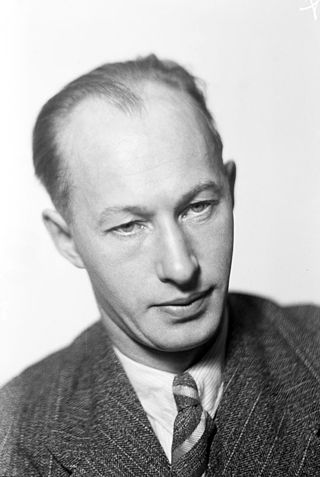
Eyvind Johnson was a Swedish novelist and short story writer. Regarded as the most groundbreaking novelist in modern Swedish literature he became a member of the Swedish Academy in 1957 and shared the 1974 Nobel Prize in Literature with Harry Martinson with the citation: for a narrative art, far-seeing in lands and ages, in the service of freedom.

The Winter War was fought in the four months following the Soviet Union's invasion of Finland on 30 November 1939. This took place three months after the German invasion of Poland that triggered the start of World War II in Europe. Sweden did not become actively involved in the conflict, but did indirectly support Finland. The Swedish Volunteer Corps provided 9,640 officers and men. The Swedish Voluntary Air Force also provided 25 aircraft that destroyed twelve Soviet aircraft while only losing six planes with only two to actual enemy action and four to accidents. Sweden also provided a portion of the weapons and equipment used by the Finns throughout the war.

Swedish Americans are Americans of Swedish descent. The history of Swedish Americans dates back to the early colonial times, with notable migration waves occurring in the 19th and early 20th centuries and approximately 1.2 million arriving between 1865–1915. These immigrants settled predominantly in the Midwest, particularly in states like Minnesota, Illinois, and Wisconsin, in similarity with other Nordic and Scandinavian Americans. Populations also grew in the Pacific Northwest in the states of Oregon and Washington at the turn of the twentieth century.
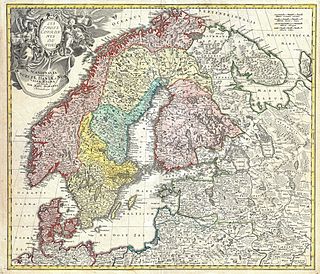
The history of Scandinavia is the history of the geographical region of Scandinavia and its peoples. The region is located in Northern Europe, and consists of Denmark, Norway and Sweden. Finland and Iceland are at times, especially in English-speaking contexts, considered part of Scandinavia.
Scandinavian literature or Nordic literature is the literature in the languages of the Nordic countries of Northern Europe. The Nordic countries include Denmark, Finland, Iceland, Norway, Sweden, and Scandinavia's associated autonomous territories. The majority of these nations and regions use North Germanic languages. Although the majority of Finns speak a Uralic language, Finnish history and literature are clearly interrelated with those of both Sweden and Norway who have shared control of various areas and who have substantial Sami populations/influences.

Gustaf Richard Yngve Larsson was a Swedish political scientist, Municipal commissioner (Borgarråd), and Member of Parliament. He was an important force in the urban development of Stockholm during the post-war years, and came to be called his century's foremost Swedish city builder and Stockholm politician.

The Nordische Gesellschaft was an association founded in 1921, with the objective of strengthening German-Nordic cultural and political cooperation. It was based in Lübeck, Germany. The association had both German and Scandinavian members. After the Nazi Party's takeover of Germany in 1933, the Nordische Gesellschaft came under the control of Alfred Rosenberg. A new board was formed. Rosenberg's ambition was that the organization could be utilized for the Nazi cause. Heinrich Himmler became a member of the board.

Racism and xenophobia have been reported and investigated in Sweden. Sweden has the most segregated labor market of people with foreign background in Europe, when measured against both high and low educational level by OECD statistics. According to the European Network Against Racism, skin color and ethnic/religious background have significant impact on an individual's opportunities in the labor market.
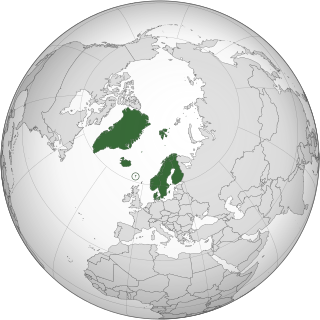
The Nordic countries are a geographical and cultural region in Northern Europe and the North Atlantic. It includes the sovereign states of Denmark, Finland, Iceland, Norway and Sweden; the autonomous territories of the Faroe Islands and Greenland; and the autonomous region of Åland.
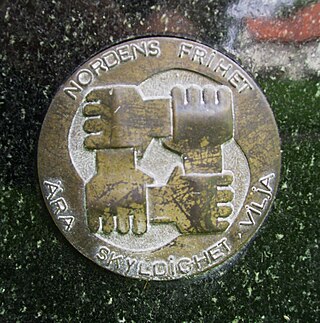
Samfundet Nordens Frihet was a Swedish association founded in 1939 to promote independence for the Nordic countries during the Second World War. The association was dissolved in 1946.

Nils Ahnlund was a Swedish historian. He was professor of history at the then-Stockholm University College 1928–1955, and became a member of the Swedish Academy in 1941. He was the father of physician Hans Olof Ahnlund, literary scientist Knut Ahnlund and the grandfather of journalist and writer Nathan Shachar.

Nordic identity in Estonia refers to the concept that Estonia is, or ought to be considered, one of the Nordic countries. The current mainstream view outside of Estonia does not usually include Estonia among Nordic countries, but categorizing it as a Nordic or Northern European country is common in Estonia.
Sweden-bashing refers to criticism of the Swedish government, the Swedish people or Sweden as a whole. The opposite of Sweden-bashing is Suecophilia.

Lieutenant General Charles Gustaf Uno Malcolm Murray was a Swedish Army officer. Commissioned as an officer in 1925, Murray served in Finnish Army as part of the Swedish Volunteer Corps during the Winter War and as company commander in the Swedish Volunteer Battalion during the Continuation War. Back in Sweden, Murray served as regimental commander of Svea Life Guards, as Inspector of the Swedish Armoured Troops and as military commander of the II Military District. After retiring from the military, Murray served as head of the Crown Prince's Royal Household and as Chief of His Majesty's Military Staff
Hjalmar von Bonsdorff was a Finnish admiral.
The People's Community Society was a Finnish-Swedish Nazi organization from 1940 to 1944, founded at Söderkulla Manor in the autumn of 1940 in Söderkulla, Sipoo, Finland. Admiral Hjalmar von Bonsdorff was elected its first chairman and Lieutenant Gunnar Lindqvist its secretary. Sipoo was in the 1930-1940s a center of Finnish-Swedish nazism, as in addition to Bonsdorff, another central Finnish nazi figure Thorvald Oljemark owned manor there. Unto Boman, among others, was present at the inaugural meeting, who in 1941–1944 served as a liaison to the Finnish Waffen-SS volunteer battalion in Berlin. According to him, the idea of forming a battalion was first presented at a meeting of the board of the SF. Other activists of the organization included Pehr Norrmén, an industrialist and banker who was also involved in the recruitment of SS volunteers in the spring of 1941, and Barons Bertil von Alfthan and Torsten Aminoff.
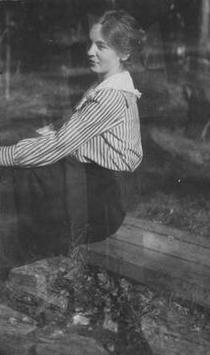
Margareta Ulrika Abenius was a Swedish literary critic, researcher, author, translator, and essayist. One of the leading voices of the Swedish literary canon in the 20th century, Abenius is best known for her biography of fellow Swedish poet Karin Boye.
Sweden was a neutral state during World War II and was not directly involved in the Holocaust in German-occupied Europe. Nonetheless, the Swedish government maintained important economic links with Nazi Germany and there was widespread awareness within the country of its policy of persecution and, from 1942, mass extermination of Jews.
Arne Folke Harald Bornebusch was a Swedish film director and screenwriter.
References
- 1 2 3 Tora Byström (2016). "Nordic solidarity in print: the Nordens Frihet Association and its magazine, 1939-45". In Peter Stadius; Jonas Harvard (eds.). Communicating the North: Media Structures and Images in the Making of the Nordic Region. Burlington: Ashgate. p. 99. ISBN 978-1-317-16357-2.
- 1 2 3 4 Erlend Eidsvik (2016). "Expressions of pan-Scandinavian sentiments in the magazine Fram among Scandinavian migrants in South Africa, 1914-1954". In Jonas Harvard; Peter Stadius (eds.). Communicating the North: Media Structures and Images in the Making of the Nordic Region. London; New York: Routledge. pp. 100–101. ISBN 978-1-317-16357-2.
- ↑ "Antinazister och nordister under andra världskriget" (in Swedish). forskning.se. 11 September 2009. Retrieved 7 March 2022.
- 1 2 "Namn att minnas – Harald Wigforss". Svensk Tidskrift (in Swedish). 31 December 1963. Archived from the original on 5 August 2020. Retrieved 7 March 2022.